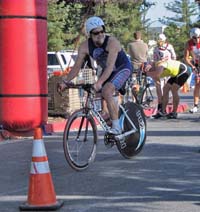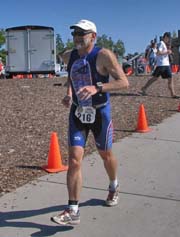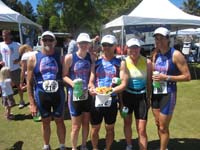 On the left is an image of me before the swim start taken by Isa Hashim.
On the left is an image of me before the swim start taken by Isa Hashim.
Note: Click on any image to obtain a larger version.
I did this race last year when it was called the "San Jose International Triathlon" (SJIT). There was a new race organizer this year, and it has a new name, but the course was the same. Or rather it was supposed to be the same.
I managed to win the race (in my age group of 55-59 year old males) in 2008, but I made the mistake of turning 60 this year, and that put me in the (presumably easier) 60-64 year old male age group. It turns out that this older group, at least for me, is far more competitive. I won two races last year, and have won none this year so far. One theory is that retirement sets in around 60, and a lot of retirees suddenly have time to train a lot and they do so. Also, in my particular case, there's a guy who's local, 60 years old, and who is a lot faster runner than I am. He passed me during the run in the two triathlons I did earlier this year and he is unmistakable. He was there at the start, so I knew it would be hard to win this year.
I rigged my bike with a disk rear wheel (hoping that there would not be a lot of wind), taped a couple of gel packets to the frame, and added an aero water bottle between the aero bars which I filled with water. I planned to push much harder on the bike to see what would happen. I've noticed that even though my legs may be burning on a bike ride, my heartrate does not go up as high as it does when I'm running hard. So I figured that maybe the pain can just be ignored, and I can get a faster time.
My triathlon club, the Silicon Valley Triathlon Club (SVTC) had reserved a couple of racks in the transition area, and I set up there, which was a good idea, socially, but a bad idea in terms of position within the transition area. The SVTC racks required an extra bit of running to get to and from the rack from the entrance and exit from the transition area. Just the bad positioning probably cost me 30 or 40 seconds.
As the start time approaches, everybody starts putting on their wet suits, and it turns out that the tighter the suit fits, the faster you will be in the water. All triathlon wetsuits have a zipper down the back, and the consequence of that plus a tight suit is that a large portion of the athletes need help getting the zipper pulled closed. (There's a cord connected to the zipper in the back that you yank when you leave the water, and this instantly unzips the suit, so it's easier to get out of the suit for the transition to the bicycle leg.) Anyway, in every triathlon I've participated in so far, I've helped a few people get their zipper closed, and I've had help from somebody to get into my wetsuit.
The gal who was racked across from me asked for help, but I couldn't do it, since she didn't have the arms or legs pulled on completely, and I pointed that out. She tried to pull them on, but she was having a devil of a time, for some reason, making jokes about how she was pretty sure she hadn't gained any weight, et cetera. Finally, she got the arms and legs on to a degree that the suit should have been zip-able, so I grabbed the cord and then saw the real problem: her wet suit was inside-out! It turns out that when you finish the swim and strip off the wetsuit as fast as possible, you always turn it inside out, but most people remember to invert their suits before the next race.
So I got my suit on and walked down to the water and another guy asked for some help with his suit and mumbled some other sentence that I didn't quite understand. Well, I took a look, and his zipper was "obviously" broken. I told him and he told me that it wasn't: that it zipped from top to bottom. Oh. That was what the mumbling was about. It's a good idea: it makes the suit even faster to unzip, but basically impossible to zip up by yourself. Knowing that, it was easy to help him zip up.
Then we waited. The organizers missed the race start, and not just by a few minutes: the first wave finally left about 20 minutes late. After that, the waves got going pretty much on time, at least relative to the first wave.
 On the left is an image of me before the swim start taken by Isa Hashim.
On the left is an image of me before the swim start taken by Isa Hashim.
My swim seemed pretty solid: I got off at the front of the pack and stayed there during the swim. One problem I've had during recent years in races is that I seem to be more prone to cramping. This year, I was lucky in that I only got one cramp, it eased up quickly, and it was a form of poetic justice. As I was swimming, there was a guy drafting me (swimming close behind me, which gives the follower an advantage). Drafting is legal during the swim and run, but it gives the drafter such an edge on a bicycle that it's illegal there. So the guy drafting me was not breaking any rules, but I thought he was following too close, banging his hands on my legs and I finally got annoyed and decided to start kicking him. So I delivered a good kick, and my leg cramped!
Besides the bad position of my bike in the transition area, the slowest part of the swim/bike and the bike/run portions seemed to be the time I was running in my bike shoes with cleats on asphalt. There are faster ways to proceed, but I haven't practiced them. For example, you can leave the shoes clipped into the pedals and run in bare feet or stocking feet. Similarly, you can leave the shoes connected to the pedals when you take your feet out after the bike leg.
The swim and transition seemed to go pretty well, but very early in the bike leg we turned south into a pretty solid headwind. It was directly in my face, which was good, since I had a disk wheel mounted, and it was easy to control the bike. When we got to the southern end of the bike route, we turned west for about one flat mile, and then one mile of climbing on the only hill on the course. The one flat mile was "interesting", since cross-winds on a disk wheel tend to buffet the bike, but it was only about a mile, and by the time the climb began, there wasn't much wind, since the hills blocked most of it.
 On the right is an image of me starting out on the bike taken by Joan Grant.
On the right is an image of me starting out on the bike taken by Joan Grant.
Throughout the bike segment, I played cat and mouse with another rider, and we must have passed each other a dozen times in the segment. We were obviously pretty evenly matched, and the constant passing and re-passing was because I was a bit better on the hills and he was a bit better on the flats. We both started in the same wave (50 years and older), but luckily, he was 53 and not in my age group, so I didn't have to put a pump in his spokes.
I knew that there was an aid station at the top of the hill (a bit more than half-way through the bike course), so I drank the rest of my water on the flat part before the climb. I had a pretty solid climb, but there was no aid station at the top of the hill, which was a little annoying, but not a giant problem, since I had a bottle of Cytomax and the route back to the transition area was not only downhill, but included a tailwind.
I tried to ride so that my legs burned for most of the route, and did pretty well. Even though my legs were burning, my heart rate never got too high. I finished the bike leg, completed my transition, and headed out for the run.
 On the left is an image of me on the run taken by Joan Grant.
On the left is an image of me on the run taken by Joan Grant.
The run course seemed roughly the same as it was the previous year which included some running along the edge of the lake and two out-and-backs. The first out-and-back seemed much longer than it had been the previous year since when I passed the 1-mile marker I noticed that on the back side of the marker was the 3-mile indication. That seemed about right since we ran for about a mile to a turnaround and then back along the same path.
The 4-mile marker seemed to come too soon but I didn't check my GPS unit against it. As we were running out toward the second turnaround one of the fastest runners in SVTC (my triathlon club) was coming back and he said something like "long run". After running a bit, I knew that it was at least a mile back to the finish, and yet my GPS said I'd been running for something like 5.5 miles. The race itself was supposed to be 6.21 miles (10 kilometers), so that seemed impossible. Well, maybe the course was slightly too long, so I expected the turnaround after the next bend. But it wasn't there. And again and again, I'd go around a corner and see runners still heading out.
Instead of being a 10k, the run was instead one of "unknown distance". Since I, and presumably everyone else, "knew" that the race was 10k, we were running as fast as we could with the plan that we'd run out of steam at 6.2 miles. The unknown distance suddenly made me a bit more conservative. Finally we got to the turnaround and at least at that point I had a pretty good idea of how far I'd have to go.
According to my GPS, the final distance was 7.36 miles: 1.15 miles of "extra credit". In spite of the extra distance I was able to hold my pace pretty well (which means, I suppose, that I should go even faster) and in fact, my average pace for the running part of this race was the fastest I've done in any recent triathlons: about a 7:48 minute/mile pace.
At about mile 4, my nemesis did pass me, so I finished the race in second place. I'm glad he passed me at mile 4, and not at mile 6.5, which would have meant that I lost the race because of the distance mismeasurement.
 On the left is a post-race photo of me and some other folks from SVTC on the run taken by Isa Hashim.
On the left is a post-race photo of me and some other folks from SVTC on the run taken by Isa Hashim.
The race organizers had some excuse for screwing up. The normal course has a shorter run on the first out-and-back and a longer one on the second. But apparently a gate on the second was locked on race day (it shouldn't have been), which shortened the second, perhaps by about a mile. The error might have been that somebody whose brain wasn't firing on all cylinders thought, "well, the second loop is a mile short, so I'll move the first turnaround out by a mile to make up for it". Or something.
In retrospect, my times were pretty good. I lost enough time in the transitions to lose the race. Here are my splits versus those of the winner:
| Name | Swim | T1 | Bike | T2 | Run | Overall |
| Bobby McKee | 0:23:22.4 | 0:02:26.2 | 1:12:04.5 | 0:00:58.1 | 0:51:54.7 | 2:30:46.0 |
| Tom Davis | 0:20:43.8 | 0:03:47.6 | 1:08:55.7 | 0:01:59.8 | 0:57:34.5 | 2:33:01.5 |
Here are two notes I sent to my coach, Lisa: the the initial one, and then a postscript.
The race went pretty well for me. I came in second in my age group. The official splits aren't published yet, but according to my calculations, my swim time was a few seconds slower than last year, my bike time was about a half-minute faster, and the run times are not comparable, since they screwed up the run course, and the distance was more like 7.4 miles instead of 6.2.
I did try to push harder on the bike course, and my HR was higher throughout. Even though my time was only about 30 seconds faster, I'm pretty happy with it because all the way to the turnaround we were pounding into a pretty decent headwind. I used the disk wheel for the first time in a triathlon (I've used it both times in the "Beat the Clock" time trial on Canada road). It worked well except for the flat part of Bailey where we had a pretty good cross-wind, but at least I was able to keep my helmet side up! It also helped to have a sort of a "pacer" on the bike: there was a guy with whom I played cat and mouse for the whole bike leg: we must have passed each other 20 times over the course of the race. Luckily he wasn't in my age group so I didn't have to put a pump in his spokes :^)
I should never have turned 60. The guy who beat me is 61 and a very good runner. The same guy ran past me at mile 8 at Wildflower, and at about mile 3 of Uvas. I finally introduced myself to him after the race, and he's a really nice guy who lives in Santa Cruz, but it looks like I'm stuck with him in my age group for a bunch of years.
It was a short race (well, other than the "extra credit" on the run) and the weather wasn't too warm so I wasn't really pushing any limits. The only cramp I got was due to poetic justice: in the swim, some guy was drafting me and kept hitting my legs with his arms and when I tried to kick him, I got a momentary leg cramp :^)
Workouts this week are going to be tough, since I'm one of the organizers of a week-long math workshop for middle-school teachers in Palo Alto that includes a lot of evening activities. I'll do the best I can.
I hope you're having a good time in Germany!
-- Tom
I forgot to say that my run pace was faster than last year. In fact, this is the fastest pace I've ever gone in the 10k (or so) of a triathlon. Previous fast pace was 7:54/mile (at Uvas this year) and yesterday was 7:48/mile. I ran with a sort of "Galloway-like" strategy: 50 paces solid then 50 fast, over and over. As I got used to it, I'd do 60 fast and 40 solid. I like the alternation: when I was hurting on the fast part, there was always the "relief" of the solid running at most 50 strides ahead.
I think that's similar to how I felt doing the team-time-trial on "Beat the Clock": when I raced it by myself, the pain level was a constant 10, but with a buddy, it was 11 when I was pulling and 9 when she was pulling for a net better time and a psychologically much easier race.
I like the short races, but in some sense they're not too useful for the things that are going to matter in an ironman. If I screw up with food or water or salt aat the Olympic distance, it doesn't really matter. I reviewed the mantras I used last time before yesterday's race, but I was concentrating so hard on every technical aspect of the race yesterday that I never used a single one. I think that the counting strides was sort of mantra-like, and my brain did keep checking to make sure that my shoulders were relaxed in the run, which was, I guess, sort of like a mantra of "relax your shoulders".
Oh, and I did great on the bike with respect to aero-position. Other than the climb up Bailey and that little bump just before you enter farm country going south, I was down for at least 99% of the time.
-- Tom
Return to my home page.
Want to send me mail? Click: ( tomrdavis@earthlink.net)